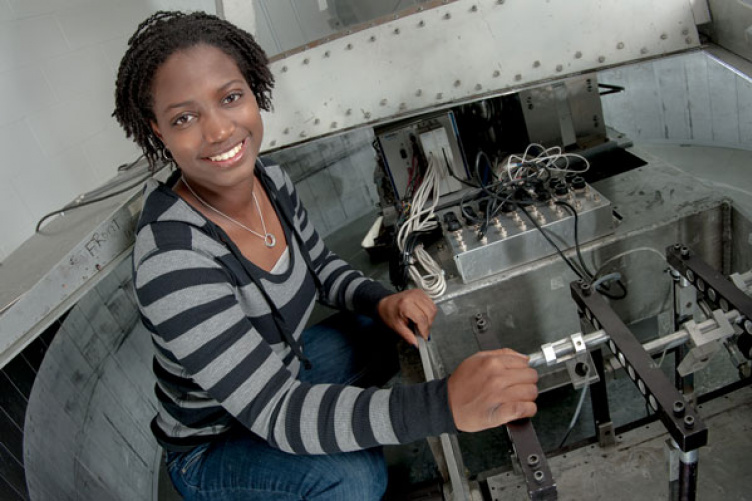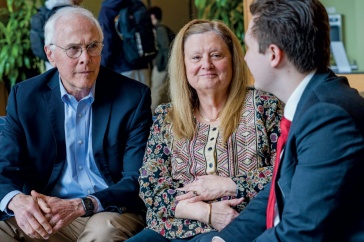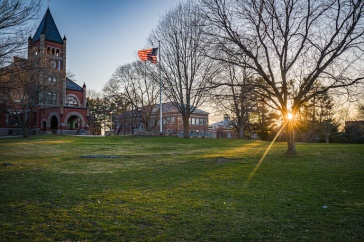
Adrienne Hill '15 perches in the centrifuge at Kingsbury Hall.
With a gymnast’s grace, civil engineering student, Adrienne Hill ’15, picks her way around the centrifuge, a large metal cylinder in Kingsbury Hall, to show how her scale model will fit into the mechanism. She explains how when the centrifuge whirls it will produce increased gravitational force to test her scale model.
The title of her research is “Experimental and Theoretical Evaluation of Internal Loads in Underground Retaining Structures.” It’s this kind of research and testing that can assure the safety of an underground garage or highway tunnel under a river.
First, Hill scales down the structure and makes a model of it. Then the model, which includes several struts or braces, is inserted into a container and surrounded with soil. For Hill’s experiment, she uses what’s known as Ottawa sand that has standardized properties.
Looking on, her faculty mentor, Assistant Professor Majid Ghayoomi, notes that the centrifuge also has what’s known as a “shaker table” that will simulate earthquake conditions. “Any kind of earthquake you want,” he says with a smile. It’s his field of research and he explains how it can get even more complicated when the soil contains water. Then soil can actually liquefy and bubble. Thankfully, Hill’s experiment is with dry sand and does not simulate earthquake conditions.

Adrienne Hill competes on the balance beam during the Eastern Atlantic Gymnastics League Championship at the Whittemore Center, March 22, 2014.
When Hill tests her model, the centrifuge will whirl at 300 rpms, producing between 50 to 70Gs, aka gravitational force. Actually it’s a measure of weight due to acceleration. Hill observes, “Astronauts generally lose consciousness at 9Gs, so this is pretty intense.”
While this research seems valuable in general, Hill states that as the world’s population grows and cities increase there will be a growing need for space. Consequently, sustainable underground structure design with better use of materials will become more critical.
Hill presented her research at this spring’s Undergraduate Research Conference. With a PowerPoint presentation that included easy-to-understand graphics and, for the uninitiated, harder-to understand calculations, Hill gave her talk with poise and humor. Her work garnered her a First-Place Poster award at the Interdisciplinary Science and Engineering Symposium in the Civil-Infrastructure category.
How did she get interested in this field? “I’ve always liked science and math, even as a kid,” says Hill. “And I like solving problems. I definitely love this field and especially underground structures – they’re really going to be a big deal.”
As a McNair Scholar, Hill has found that she likes research and plans to go on to graduate school to earn her master’s degree in either geotechnical design or construction. This summer, she will go to New Zealand for an internship with the firm Brian Perry Civil. She will undoubtedly learn more about designing structures that can withstand earthquakes.
Hill is also a student-athlete, a member of the UNH’s gymnastics team that won the 19th annual East Atlantic Gymnastics League Championship. It was the fifth highest score in the UNH gymnastic program’s history.
Gail Goodspeed, head gymnastic coach, says about this year’s team: “Team bonding and success go hand in hand. This team just really clicked from February on. We had great co-captains, Hannah Barile and Erin Machado, who are both seniors. The team had leadership in a lot of different places and Adrienne was certainly a part of that. She is really solid on vault and balance beam. She’s a great role model as well – always ready to help other people and give back.”
With a meet every weekend from January through to April, along with four to five practices a week, Hill, like all other student-athletes, has honed her time management skills. She says simply, “I like being busy. I get more done.”
Chatting with her in the Memorial Union Building (MUB) in front of the Office of Multicultural Student Affairs (OMSA), several students stop by to say hi to Hill before slipping into the office’s suite. For her, and many students of color, OMSA is a great place to hang out. Hill often does her homework in the MUB, grabs a meal, and then takes a break to socialize in OMSA.
But Hill is never still for long, and soon she is striding out onto campus, computer and presentation in hand, off to her next class.
Originally published by:
UNH Today
-
Written By:
Staff writer | Communications and Public Affairs



















































